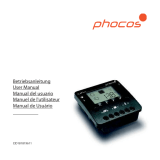
www.phocos.com
38 | Page
Réglage de la batterie
Il existe quatre options de réglage pour configurer le type de batterie.
Si le bouton « Envoyer » de la télécommande est enfoncé brièvement,
une distinction est faite entre les batteries au plomb de type GEL /
AGM et les batteries noyées. Si le lithium a été précédemment défini
comme type de batterie, cela n'a aucun effet.
Pour régler le type de batterie au lithium, ou pour passer des types
de batteries au lithium aux types de batteries plomb-acide GEL/AGM
ou noyées, le bouton "Envoyer" doit être maintenu enfoncé pendant
4 secondes.
Bouton “Envoyer” brièvement enfoncé :
Interrupteur
à bascule 3
En haut
Charge d'égalisation activée
pour les batteries au plomb
noyées
Vers le
bas
Charge d'égalisation désactivée
pour les batteries au plomb GEL
/ AGM
Interrupteur
à bascule 4
En haut
N/A
Vers le
bas
Bouton “Envoyer” enfoncé pendant 4 s :
Interrupteur à bascule 3
vers le haut et 4 vers le
haut
Électrolyte liquide de type batterie
(égalisation activée)
Basculer l'interrupteur 3
vers le bas et 4 vers le
haut
Type de batterie GEL / AGM
(égalisation désactivée)
Basculer l'interrupteur 3
vers le haut et 4 vers le
bas
Type de batterie au lithium
optimisé pour max. capacité
1
Basculer l'interrupteur 3
vers le bas et 4 vers le
bas
Type de batterie au lithium
optimisé pour max. espérance de
vie ²
1)
Tension de fin de charge (boost) : 14,4 V, tension flottante : 14,0 V
2)
Tension de fin de charge (boost) : 14,0 V, tension d'entretien :
13,8 V










































































